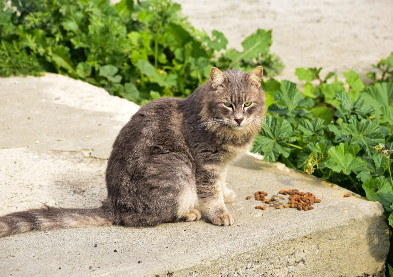Becky L. Morrow, DVM, MS, CAWA
It is no wonder that we are confused as to what the best action is to take if we find a “stray” cat outside. For over 70 years we got the message loud and clear – bring the “stray” cat to the shelter. And why wouldn’t we think this was the best thing for the cat? Sheltering, by definition, means protecting.
Unfortunately, the shelter system was not made for this purpose. You may have heard the term “dog pound” before. This more accurately reflects the original purpose of shelters, in that stray animals were impounded, held for a period of time, and released back to owners for a fee. People usually only reclaimed animals of monetary value and the impounded dogs were inhumanely killed. While shelters evolved and the methods to ending an animal’s life became humane, we can still recognize that this is not the outcome that we want. We want animals to be adopted into loving homes.
Over the years, the animal welfare community has done a great job increasing the live release rate and minimizing euthanasia due to lack of resources. Even so, there are still hundreds of thousands of healthy cats euthanized each year in animal shelters because there are not enough adopters. What those of us in this field have learned is that those deeply ingrained messages we have been sending about cats are based on antiquated sheltering methods. When we look at the data, we can see why it’s not working.
Most people that find a “stray” cat would take him to the shelter thinking that he is just lost, and the shelter will help him to find his way back to his family. What the data demonstrate however, is that only 5% of cats taken into the shelter make it back home. On the other hand, if this “stray” cat is taken into a shelter or rescue with a RTF/RTH (Return To Field/Home) program, he will have up to 50 times better chance of getting back to his family! What exactly is RTH? It is like TNR (Trap-Neuter-Return) but is not limited to “feral” cats. All free-roaming cats, or community cats, are considered for the RTH program.
Shelters with RTH programs take in cats from the community and, if they have no microchip and are doing well in their outdoor home, return them after they are spayed/neutered and vaccinated. This, of course, does not apply to cats that are found in areas where they are not being fed or cared for by members of the community or are in places that are not safe. For instance, just the other day one of my students found a cat in a park with no houses nearby. This cat appeared to be lost and was meowing and interacting with the student. The park obviously was not the cat’s home.
The cats we are returning are those that would be better served by the RTH program than by being kept in the shelter. This means most free roaming cats – those who are healthy and doing well. Cats get sick even in the best shelters due to stress and the ubiquitous nature of feline viruses. Getting cats out quickly keeps these cats healthy. Also, by returning healthy community cats to their outdoor homes, time and money is available to help other cats that would not otherwise get help. Cats who are sick or injured can now get treatment rather than being euthanized due to limited resources.
So, when you see that friendly “stray” cat in your neighborhood, think about why she is so friendly. She is likely to be getting care from one or more people. Take her to a TNR group or shelter with an RTF/RTH program. She will get spayed, vaccinated, and treated for any minor issues and sent back to her home where she can continue to live her life. Preventing our “stray” cat from having kittens allows for other kittens found outside to come into the shelters and find loving homes. Because she didn’t take up a space in the shelter, a sick or injured cat can get the medical care that he needs. Cats from hoarding cases can be rescued and treated because there are resources available. Let’s not accept the antiquated ways of the past. Let’s get cats back home.



